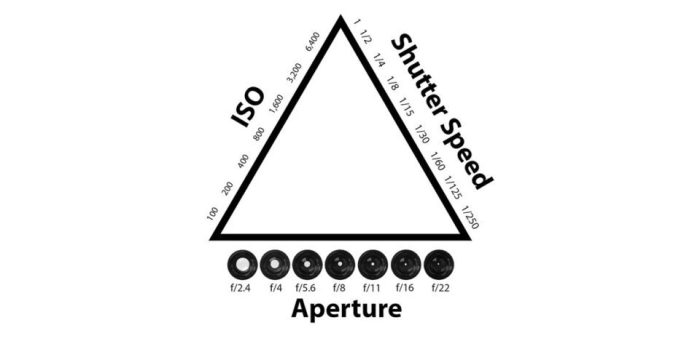
Embark on a journey to grasp the fundamentals of the photography exposure triangle with this comprehensive guide. Dive into the intricate balance between aperture, shutter speed, and ISO to capture stunning images with precision and creativity.
Explore the nuances of each element and how they intertwine to achieve perfect exposure in every shot.
Introduction to the Exposure Triangle
Understanding the exposure triangle is essential for mastering the art of photography. It involves three key elements that determine the overall exposure of a photograph.
Aperture
The aperture refers to the opening in the lens through which light enters the camera. It controls the amount of light that reaches the sensor, and it also affects the depth of field in an image. A wider aperture (small f-number) allows more light and creates a shallower depth of field, while a narrower aperture (large f-number) lets in less light with a greater depth of field.
Shutter Speed
Shutter speed dictates how long the camera’s shutter remains open to expose the sensor to light. A faster shutter speed freezes motion and is ideal for capturing fast-moving subjects, while a slower shutter speed creates motion blur and is great for conveying a sense of movement in a photo.
ISO
ISO determines the camera sensor’s sensitivity to light. A lower ISO is less sensitive and produces cleaner images but requires more light, while a higher ISO is more sensitive and suitable for low-light conditions but may introduce noise or graininess to the photo.
Understanding Aperture
Aperture is the opening in the lens through which light passes into the camera. It plays a crucial role in the exposure triangle by controlling the amount of light that reaches the camera sensor.
How Aperture Affects Light
The aperture setting determines the size of the opening in the lens. A larger aperture (small f-stop number) allows more light to enter the camera, while a smaller aperture (large f-stop number) restricts the amount of light.
Impact on Depth of Field
- A wide aperture (small f-stop like f/1.8) creates a shallow depth of field. This means that the subject is in focus while the background appears blurred, ideal for portrait photography.
- On the other hand, a narrow aperture (large f-stop like f/16) results in a deep depth of field where both the subject and background are in focus, suitable for landscape photography.
- Aperture settings can also affect the sharpness and clarity of the image, so choosing the right aperture is crucial for achieving the desired effect in your photos.
Mastering Shutter Speed
Shutter speed is a crucial element in photography that determines the amount of time light hits the camera sensor. It plays a significant role in controlling the exposure of your photos.
Significance of Shutter Speed
Shutter speed is measured in seconds or fractions of a second and directly affects the brightness or darkness of an image. A fast shutter speed allows less light to reach the sensor, resulting in a darker image, while a slow shutter speed lets more light in, creating a brighter image.
Fast Shutter Speed = Less Light = Darker Image
Slow Shutter Speed = More Light = Brighter Image
Creative Effects of Shutter Speed
Using a fast shutter speed freezes motion and is ideal for capturing action shots like sports or wildlife photography. On the other hand, a slow shutter speed can create motion blur, adding a sense of movement to your photos, perfect for capturing flowing water or light trails in night photography.
Exploring ISO
ISO is an essential component of the exposure triangle in photography, alongside aperture and shutter speed. It determines the camera sensor’s sensitivity to light, impacting the overall exposure of your image.
Importance of ISO in Photography
ISO settings allow photographers to adjust the sensitivity of the camera sensor to light. A higher ISO setting makes the sensor more sensitive, useful in low-light conditions, while a lower ISO setting reduces sensitivity, ideal for well-lit environments.
Trade-offs of High and Low ISO Settings
- High ISO:
- Useful in low-light situations, allowing you to capture images without a flash.
- Results in more digital noise or graininess in the image.
- Can affect image quality and sharpness.
- Low ISO:
- Ideal for well-lit settings, producing cleaner and sharper images.
- Reduces the risk of digital noise or grain in the final image.
- Suitable for capturing detailed shots with minimal distortion.
Practical Tips for Balancing the Exposure Triangle
When it comes to achieving the perfect exposure in your photographs, understanding how to balance the exposure triangle is essential. Here are some practical tips to help you adjust aperture, shutter speed, and ISO to get the desired results.
Adjusting Aperture
Aperture plays a crucial role in controlling the amount of light that reaches the camera sensor. Here are some tips for adjusting aperture:
- Use a wider aperture (small f-stop number) for a shallower depth of field and to let in more light in low-light situations.
- Choose a smaller aperture (higher f-stop number) for a greater depth of field, ideal for landscape photography.
Mastering Shutter Speed
Shutter speed determines how long the camera’s shutter remains open to let light in. Here are some tips for mastering shutter speed:
- Use a fast shutter speed to freeze motion in action shots or sports photography.
- Experiment with slower shutter speeds for creative motion blur effects in subjects like waterfalls or traffic.
Exploring ISO
ISO controls the sensitivity of the camera sensor to light. Here are some tips for exploring ISO settings:
- Keep ISO low (100-400) for optimal image quality and to avoid noise in well-lit conditions.
- Increase ISO in low-light situations to maintain a faster shutter speed and avoid camera shake.
Common Exposure Scenarios and Troubleshooting
It’s important to recognize common exposure scenarios and know how to troubleshoot exposure issues:
- Underexposed Images: Increase aperture, slow down shutter speed, or raise ISO to let in more light.
- Overexposed Images: Decrease aperture, speed up shutter speed, or lower ISO to reduce the amount of light reaching the sensor.
Creative Implications of Over/Underexposure
Intentionally over or underexposing images can lead to creative effects:
- Overexposure can create a dreamy, ethereal look, ideal for high-key portraits or artistic shots.
- Underexposure can add drama and moodiness to a photo, perfect for capturing a mysterious or gritty atmosphere.
Relating the Exposure Triangle to Painting

Understanding the exposure triangle in photography can be compared to color theory in painting. Both concepts involve the manipulation of light and shadow to create visually appealing artwork.
Enhancing Painting Techniques with Light and Shadow
In painting, artists use light and shadow to add depth, dimension, and realism to their work. By understanding how light interacts with different surfaces and objects, painters can create a sense of form and volume, similar to how photographers adjust exposure settings to capture the right amount of light in a scene.
- Light and shadow play a crucial role in creating contrast and highlighting focal points in a painting. Just like photographers adjust the exposure triangle to control the brightness and darkness in an image, painters use light and shadow to direct the viewer’s attention and create a sense of drama.
- By mastering the interplay of light and shadow, painters can effectively convey mood and atmosphere in their artwork. Understanding how light falls on different surfaces and objects allows artists to create realistic textures and convey emotions through color and shading.
- Similar to photographers who balance aperture, shutter speed, and ISO to achieve the desired exposure, painters manipulate the intensity and direction of light to achieve the desired effect in their paintings. Whether it’s a soft, diffused light or a bold, dramatic shadow, artists use light and shadow to evoke specific emotions and tell compelling visual stories.
Connecting the Exposure Triangle to Performing Arts
Understanding the principles of the exposure triangle can also be applied to the world of performing arts, particularly in stage lighting.
Lighting plays a crucial role in setting the mood, creating atmosphere, and enhancing storytelling in theatrical performances. Just like in photography, the manipulation of light can greatly impact the overall visual experience for the audience.
Impact of Lighting on Mood and Atmosphere
Stage lighting can evoke different emotions and enhance the overall atmosphere of a performance. By adjusting the intensity, color, and direction of light, lighting designers can create a variety of effects to support the narrative and engage the audience.
Collaboration between Performers and Lighting Designers
Collaboration between performers, directors, and lighting designers is essential to achieve the desired visual effects on stage. Through effective communication and experimentation, they can work together to enhance the storytelling and create compelling visual moments that resonate with the audience.
Applying Exposure Triangle Concepts to Philosophy
Photography, with its manipulation of light and darkness, offers a unique perspective on the concept of balance. When we apply the exposure triangle to philosophical discussions, we can uncover deeper meanings about harmony, perspective, and the interconnectedness of elements in our world.
The Symbolism of Balance and Harmony
Philosophically, the balance between light and darkness in photography can be seen as a metaphor for the delicate equilibrium we strive to achieve in our lives. Just as a well-exposed photograph requires the right combination of aperture, shutter speed, and ISO, finding balance and harmony in our existence involves careful consideration and adjustment of various elements.
- The aperture, representing the amount of light entering the camera, can symbolize our openness to new experiences and perspectives. Just as adjusting the aperture changes the depth of field in a photograph, embracing different viewpoints can lead to a richer and more profound understanding of the world around us.
- Shutter speed, controlling the duration of light exposure, reflects the pace at which we navigate life’s challenges and opportunities. By mastering the concept of shutter speed, photographers can freeze moments in time or create dynamic motion blur, highlighting the importance of timing and seizing the right opportunities.
- ISO, determining the camera’s sensitivity to light, parallels our ability to adapt to changing circumstances and environments. Like adjusting the ISO to capture clear images in low-light conditions, being flexible and resilient allows us to thrive in challenging situations and emerge stronger.
Just as the exposure triangle guides photographers in creating well-balanced and visually pleasing images, the philosophical exploration of balance and harmony can inspire us to lead more fulfilling and meaningful lives.
Perspective and Meaning in Philosophical Discourse
By considering the exposure triangle in philosophical terms, we can delve into the notions of perspective and meaning in our existence. The interplay between light and darkness in photography can serve as a powerful metaphor for the complexities of human perception and interpretation.
- Exploring different perspectives: Just as photographers experiment with angles and compositions to capture unique shots, individuals can benefit from exploring diverse viewpoints and embracing the richness of multiple perspectives.
- Finding meaning in contrast: The contrast between light and darkness in photography can symbolize the juxtaposition of joy and sorrow, hope and despair, in our lives. By acknowledging and appreciating these contrasts, we can find deeper meaning and significance in our experiences.
- Seeking clarity through balance: The exposure triangle encourages photographers to find the right balance between light and darkness to achieve optimal exposure. Similarly, in philosophical discourse, seeking clarity and understanding requires a harmonious integration of conflicting ideas and perspectives.
Analyzing the Exposure Triangle in Short Fiction
In short fiction, authors often use the exposure triangle metaphorically to enhance the storytelling experience. By exploring how light, shadow, and balance play a role in character development and plot progression, writers can create a deeper, more engaging narrative.
Symbolism of Light and Shadow
In short stories, the use of light and shadow can symbolize the internal struggles or conflicts faced by characters. Just as in photography, where light and shadow create contrast and depth, authors use these elements to highlight the complexities within their characters. For example, a character standing in the shadow may represent hidden motives or secrets, while a character bathed in light could symbolize innocence or purity.
Balancing Act for Character Development
The concept of balance in the exposure triangle can also be reflected in short fiction to show the equilibrium or imbalance in a character’s life. Authors may use the interplay of light and shadow to illustrate the internal conflicts or external challenges that characters must navigate. This balance, or lack thereof, can drive the plot forward and reveal key aspects of the character’s journey.
Examples in Short Fiction
One classic example of the exposure triangle concept in short fiction is Edgar Allan Poe’s “The Tell-Tale Heart.” In this story, the protagonist’s descent into madness is mirrored by the increasing darkness and shadows that surround him, creating a chilling atmosphere of imbalance and instability.Another example can be found in Kate Chopin’s “The Story of an Hour,” where the protagonist’s newfound sense of freedom and liberation is represented by the flood of light that fills the room after her realization.
This use of light symbolizes her emotional transformation and the shift in her perspective.By examining how authors utilize the exposure triangle metaphorically in short fiction, readers can gain a deeper understanding of the underlying themes and meanings embedded in the narrative.
Visual Graphic Arts and the Exposure Triangle

When it comes to visual graphic arts, understanding the exposure triangle can play a crucial role in creating captivating and impactful designs. Graphic designers utilize the principles of the exposure triangle to manipulate light and shadow, ultimately influencing the overall look and feel of their compositions.
Role of Contrast, Brightness, and Saturation
Graphic designers often rely on contrast, brightness, and saturation to enhance the visual appeal of their designs. By adjusting these elements, they can create dynamic and eye-catching artwork that grabs the viewer’s attention.
Manipulating Light and Shadow for Emotional Impact
- Graphic artists can use light and shadow to evoke specific emotions in their work. By playing with the exposure triangle settings, they can create dramatic effects that convey mood and atmosphere.
- Increasing contrast can add intensity and depth to a design, while adjusting brightness can create a sense of focus or highlight specific elements. Saturation, on the other hand, can impact the overall vibrancy and richness of colors.
Tips for Graphic Artists
- Experiment with different exposure settings to see how they affect the overall look of your design.
- Consider the emotional impact you want to achieve and adjust the exposure triangle accordingly to enhance that feeling.
- Pay attention to how light and shadow interact in your compositions, as they can greatly influence the mood and storytelling of your artwork.
In conclusion, mastering the exposure triangle is the key to unlocking your full potential as a photographer. By understanding and manipulating these elements, you can elevate your photography skills to new heights and capture breathtaking moments with ease.
Questions Often Asked
How does aperture impact depth of field?
Aperture controls the amount of light entering the camera, which in turn affects the depth of field. A wider aperture (lower f-stop) results in a shallower depth of field, while a narrower aperture (higher f-stop) increases depth of field.
What are the creative effects of using slow shutter speeds?
Slow shutter speeds can create motion blur effects, ideal for capturing flowing water or light trails. They also allow for long exposure shots in low light conditions, resulting in unique and artistic images.
How does ISO impact image quality?
ISO determines the camera sensor’s sensitivity to light. Higher ISO settings increase sensor sensitivity, but also introduce more noise or grain in the image. Lower ISO settings produce cleaner images but may require more light.






